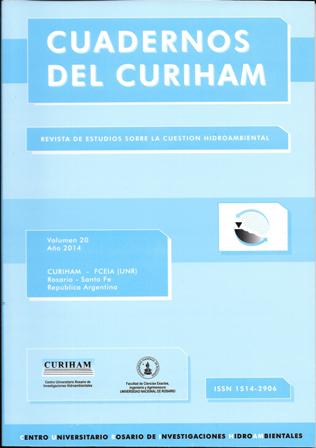Remoción de arsénico (as) y fluoruros (f-) en aguas subterráneas mediante coagulación, adsorción y doble filtración
DOI:
https://doi.org/10.35305/curiham.v20i0.87Keywords:
Arsenic, Fluoride, Groundwater, Coagulation-adsorption, Double filtrationAbstract
The presence of arsenic (As) in drinking water has caused the spread of Chronic Regional Endemic Hydroarsenicism (HACRE), this is a disease that causes skin lesions and different types of cancers. Regarding the presence of fluoride (F- ) in drinking water, lower concentrations to 1.5 mg/L protect the dentures of children who use them, but it has been shown that higher concentrations of F- to 2 mg/L generate dental fluorosis (stained teeth) and deseases affecting the bones such as skeletal fluorosis. At the Center for Sanitary Engineering (CIS) thas been developed a process for the removal of As and F- in groundwater which has low total salinity. The ArCIS-UNR® process consists of a coagulation-adsorption process on aluminum hydroxide flocs, initial pH correction and two filtration stages: a first coarse upflow gravel prefiltration then rapid filtration. This process achieves As concentrations less than 0.05 mg/L in treated water (with a more controlled operation 0.02 mg/L), and 1.5 mg/L of F- , and is being applied to real scale in populations up to 10000 inhabitants. However, ArCIS-UNR® process is requested for cities with larger population and with higher concentrations of F- in the water to be treated. Therefore it was proposed to modify the original process, on the one hand to work with a initial pH of 6, because according on previous research, the F- removes better at low pH, and on the other hand to replace the coarse prefiltration stage by an stage of upflow rapid filtration so it could be possible to work with higher flow rates with lower filter surface. Preliminary tests indicate that this new scheme can achieve good results in terms of removal of As and F- . For concentrations of As in the raw water between 0.08 and 0.12 mg/L, outlet concentrations were obtained in the treated water < 0.02 mg/L. While initial concentrations of F- to between 2.7 and 3.0 mg/L, outlet concentrations between 1.4 and 1.6 mg/L were achieved.
Downloads
Downloads
Published
How to Cite
Issue
Section
License
Copyright (c) 2014 Albertina González, Ana María Ingallinella, Virginia Pacini, Rubén Fernández, Graciela Sanguinetti, Hernán Quevedo

This work is licensed under a Creative Commons Attribution-NonCommercial-ShareAlike 4.0 International License.



























